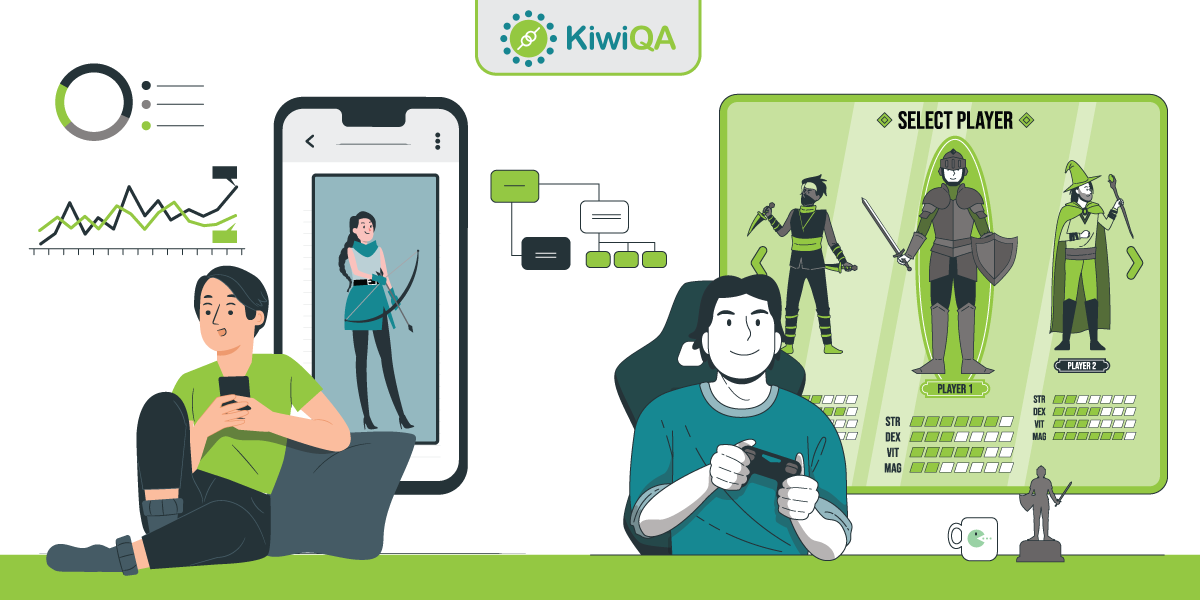The rapid proliferation of mobile phones, mobile internet, and easy accessibility, has resulted in the growing popularity of online gaming. Nowadays, consumers can play games from devices like laptops, tablets, mobile phones, and more. As per Nielsen report1, the gaming industry was at an all-time high during the COVID-19 pandemic.
Since online gaming continues to remain such a huge market, a growing number of companies are eager to eat a share of the pie. This also means that a number of gaming apps are uploaded on a regular basis to the Apple App Store and Play Store. Picture this – Close to 3800 apps2 are uploaded on a daily basis to the Play Store.
With such kind of stiff competition, it becomes imperative to focus on all-round aspects of the application. The same principle also applies to online games since there are close to 2.8 billion gamers as of 2021. The advent of 5G will further transform the online gaming market.
Game developers are always under the pressure to release frequent updates, else it could have a negative impact on the DAU (Daily Active Users) of the game. The inclusion of AR (Augmented Reality), cloud streaming technologies, gesture controls, and A/V (Audio/Video) has made game development much more complex than before. A single negative review of the app could dampen the growth of the gaming application.
Along with game development, acute focus must be put on game testing since that will help in providing a frictionless experience to the end-users of the game. Our experience in providing game testing services to a number of reputed clients helped us in identifying obstacles in game testing. The learnings of this blog will help you in building a scalable, reliable, and formidable game testing strategy for mobile devices.
Also Read – Detailed Mobile Game Testing Checklist
What is Mobile Game Testing?
As the name indicates, testing of mobile gaming applications involves testing the various aspects of the game on different device viewports and/or devices. The intent of gaming testing is to improve the stability, reliability, scalability, and security of the mobile game.
Mobile game testing is very much different from the testing of other types of mobile applications. Testing of games includes validation of the game play, leaderboard, game graphics, performance and stress tests, amongst others.
Since a majority of mobile games involve a good amount of consumption on CPU and GPU front, it becomes essential to test the mobile games on real devices on which the target users can install the game. Since there is a huge fragmentation when it comes to viewport sizes, device configurations, etc.; you have to prioritize the tests on devices that are in high demand.
Leveraging the best practices in mobile game testing to make the most out of the test cases (or suites) developed for testing the respective game. As per our experience, there is a possibility that you might still face certain hurdles when performing game testing. We look at the common obstacles and how to surpass them like a champ 🙂
Obstacles In Mobile Game Testing
Now that we have covered the important aspects of testing mobile games, let’s look at why this form of testing is different from other types of software testing.
Prioritization of Real Devices for Testing
It is important to understand that there is a massive difference between mobile games and other forms of mobile applications. For example, an e-commerce application (irrespective of its complexity) will not be so CPU or GPU heavy when compared to mobile games.
Graphics and performance are some of the most integral aspects of any type of mobile game. Hence, testing of the game on emulators or simulators would not yield much results since the game cannot be tested from a performance and stability point of view. In real devices, the CPU and/or GPU frequencies would be throttling depending on the load at that point in time. This is why games must be tested on real devices only.
However, the growing challenge is identifying the devices on which testing must be performed on priority. Building an inhouse mobile device farm is not a feasible solution since it would require continuous maintenance and upgradation.
The first step to reliable and scalable mobile game testing is prioritizing the devices that are widely used in your target market. Once you have done that, the next step is to opt for a cloud device lab (or mobile device cloud) so that you can shed the expenses involved in procuring and maintaining the mobile devices.
Also Read – Best Practices of Mobile Game Testing
Automation Frameworks for Functional Testing
Testing mobile games is altogether a different ball game when compared to testing other categories of mobile applications (e.g. e-commerce, banking, etc.). None of those apps would require the mobile phone to operate at higher clock speeds!
Understandably, manual testing of mobile gaming apps is not enough since it is not a scalable option. Also, automated testing of gaming apps does not just involve searching for WebElements and automating interactions with the elements. It involves a much more complex piece of logic than automated testing of websites (or web apps).
Specialized test tools like AltUnity are required for creating scalable and maintainable test scripts for Unity-based games. Majority of the times, the gaming engines and tools are not supported by standard mobile app testing frameworks like Appium.
This is where GameDriver3 agent can come super handy, as it helps in automating the entire gameplay. You can locate bugs, improve overall test coverage, and enhance the end-user gaming experience by testing with GameDriver. It currently supports only Unity.
The API testing experience that the game testing companies onboarded by your team can be leveraged since GameDriver also offers REST APIs. Like other popular automation tools (or frameworks), tests created using GameDriver can be run in a CI pipeline. Akin to Selenium IDE (the popular record & playback tool), GameDriver also provides a Game Recorder (still in Alpha stage) to record interactions with the elements of the game.
It is essential to partner with one of the best game testing companies in order to choose the right tools and frameworks that can accelerate developer feedback and time to market.
Game Performance is the key
Just like time spent on page, time spent on site, etc. are important for websites (or web apps); experience and performance are the key drivers for the growth of any mobile game. Momentary sluggishness in the mobile game can be a huge dampener to the experience.
Frame drops, battery drain & excessive overheating when the game is operational, etc. are some of the factors that must be avoided (or minimized) at all costs. Game performance must be thoroughly tested after the introduction of any new feature. Green signal from staging to production must only be given if all the performance parameters are met.
In order to realize this requirement, you need to consider cloud-based tools like Headspin that provide the testing infrastructure to test various aspects of the mobile games. Leveraging the potential of their infrastructure and automated testing; your team can identify the major cause of frame drops, perform a thorough audit at the code-level, and zero-down on issues occurring due to network throttling, server issues, and more.
Also Read – Different Stages of Game Testing
Testing in-app purchase scenarios
In-app purchases and premium game subscription are two of the most widely used revenue models by game developers across the globe. The freemium version of the game is normally instrumental in creating the habit-forming loop , which in turn is a huge motivator for the users to upgrade to the premium version. Users get access to all the locked features with the premium subscription.
In-app purchase4 is another way in which gaming companies (or game developers) generate revenue. However, the complete purchase flow has to be thoroughly tested using the combination of manual and automated testing. In-app revenue can hit a roadblock in case there are glitches in the in-app purchase flow.
All the touch points from where the users can purchase (or upgrade account) must be tested using automation testing tools or frameworks. Since almost all the games have a global audience, all the tests have to be conducted taking the geolocations into consideration. Localization testing will also come into picture for in-app purchases, as important purchase messages might need to be localized for the intended audience.
These tests can also be performed using real devices on the cloud, as tests can be conducted in parallel and at a large scale on a range of mobile devices.
Also Read – Major Game Testing Challenges Game Testers Face
It’s A Wrap
Gamification and top-class user experience are some of the major factors that can keep gamers hooked on to the game. However, things are easier said than done. In order to achieve the best user stickiness, all the aspects of the game (i.e. game logic, game performance, in-app purchase, impact on battery consumption, impact on thermals on the device, etc.) have to be tested in a thorough manner.
This is where the combination of automated testing and CI/CD can be leveraged to test the game features at a large scale. The obstacles highlighted in this blog can be overcome by choosing the best testing infrastructure and onboarding the ideal game testing services company so that high-quality games can be released at high speeds!










